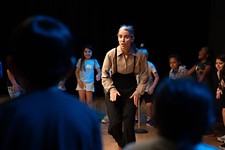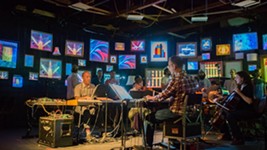KMFA's New Home Brings the Community Into Contact With Music
Austin's classical music radio station has a new building where people can see the sounds
By Robert Faires, Fri., Jan. 29, 2021
Ann Hume Wilson has the sun in her eyes.
In most buildings, that would be unremarkable. But this is KMFA. For more than four decades, Austin's classical radio station – 89.5 on your FM dial – was ensconced in a leased space on North Lamar that may be best likened to a submarine: a long, narrow tube of a hallway running the length of the building on the ground floor, with virtually no natural light infiltrating the studios and offices off of it, a space so tightly enclosed that on your way to see Wilson or on-air personalities such as Dianne Donovan or Sara Schneider, you'd half-expect to pass a periscope station or torpedo tube.
That's all changed now. KMFA has ditched the rented digs for a home of its own, one so open and airy that, as its president and general manager sits in her office there and explains how a niche-audience public radio station came to build a new $11 million headquarters, one can follow the light of the afternoon sun as it rises up the wall to the point where it almost blinds her.
In this room and throughout the 18,000-sq.-ft. facility, windows let the sunshine in, brightening the workspace for the KMFA staff (whose No. 1 response to what they'd like to see in a new home was "more light"). But they're also making a statement that this isn't a sealed temple just for the classical faithful. It's a place that is open to all.
That message was key in the building's design and development. Windows fill the space inside as well as out, giving views into offices, community rooms, and, of course, broadcast studios, making the workings of the station and the people behind them visible. The facility includes spacious areas downstairs and up for people to gather and interact. There's a gallery that helps visitors experience music beyond what radio can provide – something delivered joyfully by Steve Parker's Sound Garden installation, a junkyard assortment of brass instrument parts, instrument cases, violins, drums, pipes, bellows, lids, and wires that emit sounds, rhythms, and music samples when touched. And the building's crown jewel is a performance space, in which up to 135 people can enjoy live performances of music. It may be the home for a radio station that plays classical music, but it has the feel of a home for the entire community.
If you're wondering how a modest local organization playing what some might consider outdated music on what some might consider an outdated medium could construct a multimillion-dollar facility, then think about the concept of community. KMFA still proudly proclaims itself to be a classical music station, but that doesn't mean it's just playing to a tiny cluster of bluehairs and whitehairs who want to hear Debussy's "Clair de Lune" and Pachelbel's "Canon in D" for the thousandth time. For years, KMFA's been actively expanding its musical range to feature early music, film scores, show tunes, compositions throughout the 20th century, and even music from the last 20 years – including works by Austinites. With that expansion comes a broader swath of listeners, and KMFA's taken advantage of the Age of Streaming to make new fans beyond our city limits. Wilson shares the story of one who wrote recently: He lives in rural Kentucky and discovered KMFA through iHeartRadio, and since he turned it on, he hasn't stopped listening. And apparently, he isn't alone, as Wilson reports that during the pandemic listenership has gone up 20% – notably among twentysomethings. Call it classical's calming factor in turbulent times or what you will, but it's evidence that classical radio is still relevant in the 2020s.

For KMFA, though, community isn't only the people tuning in. It's also Austin's musicians and the organizations they play with and other artists in the city and their organizations and all of their audiences. It's students learning to play music and those just discovering music and those who have yet to discover music. It's their teachers and parents and anyone who might be interested in music or the arts. The station has long made a point of promoting local culture on-air and online, to get more members of the community to engage with music, theatre, dance, and art. So when, after a half-century, KMFA was finally able to create its own home, of course it was going to make spaces in it for people to have direct contact with art. That's why the gallery and the Draylen Mason Music Studio say so much about KMFA's new facility: They're about something more than the station and what it sends through our speakers, what it gives to our ears. These spaces also offer something for our eyes, sounds we can see.
That the performance studio is named for Draylen Mason, the young musician killed by a package bomb in 2018, says something else about KMFA and community. Major gifts to a new building such as KMFA's commonly come with naming rights for part of it – a hallway, a staircase, a room – and often it's the donor's name that ends up on the space. But Lynne Dobson and Greg Wooldridge chose not to have their names on the music studio they funded. Instead, Dobson, who was shaken by Draylen's death and wanted to do something for him and his family, was introduced to Draylen's mother, Shamika Wilson. Through their connection came the idea of naming the studio for Draylen. In life, he had played in the old KMFA studio as a part of Austin Soundwaves, but the naming gesture was less about that tie to the station than about recognizing the passion and promise of a young man who believed that his greatest gift was affecting someone through sharing his musical talents. He had a valuable place in the community, and now KMFA could ensure that he will have one in perpetuity.
The station had planned a grand opening for the studio this weekend, to coincide with the 54th anniversary of KMFA hitting the airwaves. An in-person celebration had to be canceled, but a series of virtual concerts by prominent musicians – violinist Anne Akiko Meyers, pianist Olga Kern, the Miró Quartet with pianist Anton Nel and cellist Douglas Harvey, violinist Vadim Gluzman, and pianist Angela Yoffe – will be streamed Friday, Saturday, and Sunday (see schedule, at right). And a portrait of Draylen commissioned from artist/activist Nikkolas Smith will be unveiled.
So KMFA's new home isn't open to the public yet – another unfortunate side effect of life under COVID-19 – but when the time is right, this station will welcome everyone into it. After all, it's a building made for people to stream in like sunlight.
The Road to KMFA's New Home
People have been wanting to get KMFA out of the submarine on North Lamar since the turn of the century, according to the station's president and general manager, Ann Hume Wilson. She says that when she joined the station in 2012, she found comments about finding a new space in board minutes going back 20 years. But the station's sweet deal on rent kept a move from being pursued; it was said the arrangement was too good to give up. Any steps toward finding a new home were, in Wilson's words, "tentative."

But it's funny how attitudes change with $3 million in the bank. That's what a KMFA supporter left the station in a bequest, and it got the ball for a new facility rolling. A six-figure gift from Lynne Dobson and Greg Wooldridge to fund a music studio in the new space added momentum, then more six-figure donations came in, some from donors who hadn't made even four-figure contributions previously. Probably the most effective tool Wilson had for encouraging capital campaign support was inviting potential donors to the North Lamar facility. Once they saw for themselves the cramped conditions, they'd tell her, "Oh, you need a new building."
A search for properties eventually led to the Hatchery, an 18-acre mixed-use development in East Austin being built on the site of a former National Fish Hatchery, where fish were raised to stock ponds across Texas from the Forties through the Sixties. With a spot on Navasota, KMFA became the anchor for the development.
Sixthriver Architects and STG Design designed the 18,000-sq.-ft. facility, which is as spacious and open as KMFA's former space was crowded and tight, with expansive lobbies on both floors, a large terrace, and numerous windows filling the entire building with light. Aside from station offices and broadcast studios, the building includes a gallery for interactive art pieces and a 135-seat hall for live performance, the Draylen Mason Music Studio. Nods to the station's musical heritage are all about. Wood surfaces suggest string instruments. A wall pattern of staggered vertical lines is revealed on close inspection to be rows of LPs. Blocks in another pattern are covered with sheet music. Black and white vertical bricks on one wall are arranged to form the sound waves to the opening of "The William Tell Overture," the first music played on KMFA in 1967.
The interior still has some finishing work being done, but the staff has been broadcasting from the new building since mid-October. Currently, the $11 million facility is 88% funded. It needs another $1.3 million to be raised to cover construction costs and $2.5 million to cover an endowment and reserves. For more information on the capital campaign, visit www.dearmusic.org.
Live From the Draylen Mason Grand Opening, Friday-Sunday, Jan. 29-31
"You know, you get that black-box coldness in some spaces, and you get the rich, living-room vibes in others. This is that." That's Carla McElhaney, host of KMFA's Night Music and director of creative learning, on the new Draylen Mason Music Studio. She talks about its warmth, its intimacy, the way it allows a performer freedom. "To me, it's magic." Which is just what you want to hear from the artistic director for the studio – the latest role for McElhaney at KMFA.
The space has had a few test runs so far – Austin Chamber Music Center's A Charlie Brown Christmas and Kindred Spirits – but this weekend is its official debut. The Grand Opening Weekend features special concerts Friday through Sunday, all streamed alas, but some of which were recorded in the Draylen Mason Studio. Tickets, which range from $20-250, can be purchased at www.kmfa.org/live. Here's the lineup:
Opening Night: Live from the Draylen Mason
Friday, Jan. 29, 7pm
The Draylen Mason Music Studio is dedicated with the unveiling of a portrait of Draylen by Nikkolas Smith, followed by a concert by violinist Vadim Gluzman and pianist Angela Yoffe.
Anne Akiko Meyers & Jason Vieaux, Olga Kern: Live from the Draylen Mason
Saturday, Jan. 30, 7pm
Pianist Olga Kern provides a special performance from Prague, followed by acclaimed violinist – and former Austinite – Anne Akiko Meyers performing with guitarist Jason Vieaux.
Miró Quartet & Friends: Live from the Draylen Mason
Sunday, Jan. 31, 4pm
Austin's celebrated Miró Quartet performs, with guest appearances by pianist Anton Nel, Austin Symphony Orchestra principal cellist Douglas Harvey, and double bassists Utah Hamrick and Joel Braun.
For information on free on-demand concerts, visit www.ourconcerts.live/kmfa.














